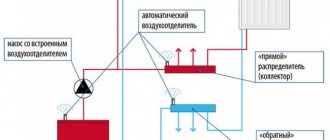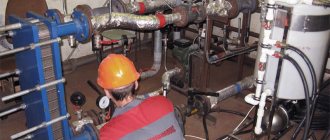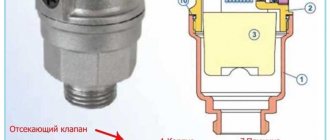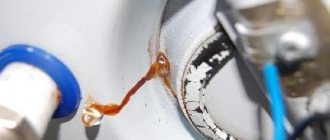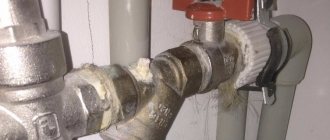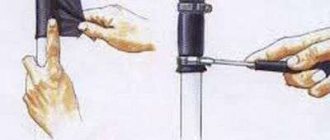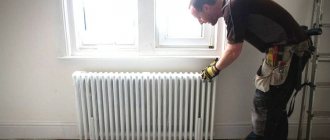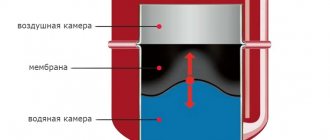Home » Insulation
Reading time 12 min Published 08/17/2019
Every year before the heating season, utility services notify citizens living in high-rise apartments that it is necessary to bleed air from the heating system. The reasons for the formation of air in the heating system are factors such as the release of hydrogen during chemical reactions, as well as repair work, as a result of which water is drained from the system. To remove air, special devices are used - air vents.
Air vents for heating systems are also called air release valves, without which it is impossible to ensure the normal functioning of the heating system.
Air in the heating system: causes
Air enters the heating system for a number of reasons:
- filling the line with water, resulting in the formation of air accumulation areas;
- violation of the quality of sealing devices;
- corrosion processes occurring inside pipelines;
- improper execution of installation work.
The main reason why it is necessary to remove air from the heating system is that oxygen contributes to the creation of air pockets. These plugs help reduce pressure and also reduce the rate of coolant circulation. If you do not bleed the air mixture in the heating radiators, you may experience a process such as a lack of heating of the battery sections.
Removing air from the system during operation
However, with all the measures taken, the formation of traffic jams is possible during operation. The reasons why the heating system will air are discussed above, and we will not return to them again. However, it is necessary to consider how to properly ventilate the heating system during its operation.
When faced with such a task, you need to act as follows:
- Determine the place where the air has collected. This can be done by noise or pipes and radiators, they are colder in such places.
We are looking for a point located higher in the direction of movement of the coolant, at which there is a Mayevsky valve through which air can be released.
This is a universal, standard algorithm of actions that allows you not to think about how to eliminate air from the heating system.
The operation of heating any home largely depends on its correct installation and provision of the necessary conditions during operation. One of them is the lack of air in the heating system. The use of the necessary equipment and proper operation will create the prerequisites for its long-term and trouble-free operation.
What types of air vents are there?
Air vents are divided into two types:
Manual products are designed to deflate air through human intervention. To do this, utility workers either independently go around all the apartments to carry out such manipulations, or inform the residents of the house. Automatic air vents for heating systems do not require human intervention, so they release oxygen on their own. The cost of such devices is several times higher than manual ones, so utility services are not able to provide all high-rise apartments with automatic air vents.
Automatic air vents are installed in places where there is a high probability of air lock formation. The locations for such devices are heating radiators.
Mayevsky crane
Of course, Mayevsky’s faucet does not belong to the category of automatic air vents, so it seems to be off topic of the article. But there’s not much to write about it, and since it’s still an air vent, a few words about it here.
Mayevsky taps are installed on radiators:
To bleed air, you just need to slightly open the screw on the tap with a screwdriver:
The blue arrow shows where the air will come out from.
If initially (when installing heating) we plan to install a Mayevsky tap, then we need to install the radiator so that the part where the tap is “looks” upward (1...2 cm higher).
What are the dangers of not having air vents?
Air vents are used not only in heating networks of multi-storey buildings, but also in private ones. Each radiator is equipped with an air vent, which is often presented as a manual type.
The air inside the heating system impedes the circulation of the coolant, which negatively affects the heating of the premises. If you do not bleed air from the system in a timely manner, vibration is created when the coolant heats up. This phenomenon can ultimately lead to physical damage to the heating network circuits. The main places of damage are the connection points of heating radiators, as well as welding or soldering seams.
If there is no air in the metal pipe circuit, then the internal walls of the pipelines do not corrode, unlike in cases where there is oxygen in the system. When the internal walls of pipelines rust, not only does the service life decrease, but also the coolant becomes clogged. Draining or bleeding air is a prerequisite, since residents of houses and apartments who ignore to carry out such a procedure themselves may be left without heat.
Where to install the security group
The safety group is installed on the supply pipeline, near the heating boiler so that the pressure gauge readings are visible at a distance of a meter from the device. Valves cannot be installed between the safety group and the boiler (except for shut-off valves, but even those are undesirable).
You must train yourself to pay attention to the safety team every time you visit the boiler room in order to take timely measures if problems arise in the operation of the equipment.
The pressure gauge should be positioned so that its readings can be seen without straining during any visit to the boiler room. The coolant flowing out through the safety valve should also be easily noticeable, because it is imperative to be aware of such a phenomenon!
Features of the functioning of manual descenders
The design of the simplest manual air vent is shown in the diagram below.
This air vent is called the Mayevsky crane, the operating principle of which is very simple. The device has two holes that are covered by a threaded element. When unscrewing the threaded element, air is released, which is pushed through the 2 mm hole in the diagram above, and exits the system through the second hole.
To bleed air from the system, it is enough to make 2-4 turns of the screw, after which, under the pressure of the coolant, the air will tend to escape through the holes. You can know that all the air has been drained from the system by the appearance of water flowing out of the hole. As soon as a dense stream of water flows from the hole, you need to screw the screw in until it stops. Modern Mayevsky cranes are presented in various types: turnkey, with handles and even with a screwdriver. The photo below shows a list of such types.
A manual air valve in a heating system is an ideal device that functions flawlessly over a long period of time. The reliability of this device is due to the absence of moving parts, which over time are subject to clogging, corrosion and failure. This is typical for automatic air exhaust products.
Often, instead of Mayevsky’s manual taps, apartment owners install drainage taps. They can be installed temporarily, but not permanently, since they are not intended for installation on radiators. If such products fail, it will be very difficult to replace them during the heating season.
DIY security group
You can make a security group yourself, but it will most likely cost more than a security group purchased pre-assembled. You need to buy a pressure gauge, an air vent and a safety valve, and then connect them using tees, bends and adapters in the manner of ready-made safety groups.
Homemade safety group for heating. Photo: mlhouse.ru
Source
How does an automatic air vent work?
Let's figure out how an automatic air vent works, the cost of which is 2-3 times higher than manual devices. Such products are equipped with air release valves that function without outside intervention. The design of the product is a vertical barrel with a ½-inch threaded connection method. The body of the product is made of brass, and inside the device there is a plastic float. This float is connected to the spring-loaded air release valve and the cap.
Automatic air vents have ½ and 3/8 inch threads. The last option comes up rarely.
The operating principle of the automatic air valve is to perform the following tasks:
- If there is no air in the system, the chamber of the device is filled with water, which presses the float to the top. In this case, the spring-loaded valve is in the closed position.
- When air enters the system, the pressure decreases, so the float drops.
- When the pressure decreases to a certain value, the mass of the float device will overcome the spring, which will lead to the opening of the valve.
- The excess pressure will force air out of the circuit, after which the valve will close again.
The diagram shows in detail how the automatic air vent functions. The advantage of such a product is the complete absence of water leakage, since the device leaves some of the air mixture inside, which does not negatively affect the operation of the heating network.
Depending on the type of connection, automatic air vents can be straight or angular. The photo above shows a corner air vent with a jet in the upper part. On direct devices, such a jet is located on the side. The products differ from each other not only structurally, but also technologically. A valve with a side outlet is more reliable, but it does not retain air as well as a device with a vertical outlet.
Automatic air vent valves from the heating system are constantly being modernized, as manufacturers strive to make them more advanced. At the same time, they are complemented by various functions:
- Elimination of water hammer, which is facilitated by a special plate inside the product.
Design and principle of operation of the air vent
Due to various circumstances, an air lock may appear in water heating systems, preventing the normal circulation of the coolant. As a result, part of the radiator or several batteries located on the same branch or riser cool down. So that the air that appears can leave the system on its own, an air vent operating in automatic mode is installed at certain points.
The device is a sealed metal case with a connecting pipe located at the bottom. Inside the body, in the chamber, there is a float made of polymer material, connected by a rod to a needle valve, the hole of which is made at the very top of the lid. The air vent device is shown in detail in the diagram:
The normal state of the air separator is when the body is filled with coolant, the float is raised to the maximum upper position, and the needle valve is closed. Over time, air from the network enters in small portions into the chamber of the device and displaces water.
The float gradually lowers and at a critical point begins to open the valve communicating with the atmosphere through draft. Thanks to this, all the air accumulated in the chamber under water pressure quickly leaves it through the open hole. This is the operating principle of the automatic air vent, as shown in the figure:
After all the air has gone out, water takes its place in the chamber, raising the float to its original position. The valve closes and the air vent goes into standby mode. The automatic float air vent also plays a very important role when emptying the system or its section. Since when the coolant level in the chamber decreases, the lever will open the valve, this will allow air to enter the system and thereby speed up its emptying.
Features of choosing air vents
Not everyone knows where to start choosing an automatic air vent. In order for the product to serve for a long time and without failure, it is recommended to buy products of European or domestic production, but not cheap Chinese counterfeits. Buying a cheap automatic graduate can cause the following adverse consequences:
- Passing not only air, but also coolant through the valve. In this case, a puddle of water will be detected under the radiators or in the places where the air vents are installed.
- The product is jammed, so it will not work.
- Rapid deterioration.
Although automatic type safety valves have a shorter service life than manual ones, they must serve without fail for at least 10 years. Manual products have a service life of over 15 years, so instead of buying a cheap machine, it is better to give preference to a manual device. This will allow you to win not only in terms of savings, but there will also be no problems with air bleeding.
To choose good quality Mayevsky uranium, you need to pay attention to the following criteria:
- The presence of a handle allows you to conveniently open the valve for bleeding air. The disadvantage of faucets with handles is that they can be accessed by children, who are quite capable of opening them. Installation of such outlets with handles is appropriate only in hard-to-reach places; in other cases, it is recommended to install conventional products with a key or a screwdriver.
- To avoid losing the special bleeder key, it should be placed on the wall next to the radiator. This will prevent you from losing the key, and will also allow you to quickly bleed the air.
- Buy products with anodized coating. This spraying allows you to protect the metal from the occurrence of oxidative processes.
- If your budget allows, you can purchase a product that can trap air bubbles. However, such manual air vents do not differ much in cost from automatic air vents.
In order not to make a mistake with your choice, you need to pay attention to the manufacturer. Depending on the brand of plumbing and heating equipment, not only the quality, but also the cost will differ. In addition, if a closed heating system is used, then you need to pay attention to the technical parameters of the devices, in particular, operating pressure.
The air in the heating system is one of its main enemies. Therefore, automatic air vents must be provided in the heating system. Since not all heating systems operate on the same principle, the process of air circulation in the circuit also differs. Before you bleed air from the heating system, you should figure out how to do this, or you don’t need to do anything and it will come out on its own, for example, like in an open system.
Corner and radiator air vents
In different heating systems, many situations may arise when it is necessary to remove air pockets in the most inaccessible or remote places. It is impossible to list them all, as there are too many options. Where it is not possible to install a simple valve because the threaded pipe at the end is in a horizontal position, an angled air vent will do. Its pipe, coming out from the bottom, turns at an angle of 90º and can be connected to a horizontal section.
It should be noted that an angular air vent with an external threaded connection is no different from a conventional straight valve except for a rotated pipe and can be used instead of it if necessary.
Often, to automatically bleed air from batteries, instead of the traditional Mayevsky tap, some users install an angle valve. This can be relevant in an unpleasant set of circumstances, when gases are constantly formed in the network and this happens precisely in radiators. The reason is a chemical reaction of substances sometimes present in water with the aluminum alloy of batteries at elevated temperatures. There is no point in installing a valve with an angle pipe, because there is a special automatic air vent for radiators, shown in the photo:
These devices are designed for batteries only and have a suitable threaded connection. Instead of manual taps, it is preferable to place them on heaters made of aluminum or partially bimetallic, where there is also contact between the alloy and water. In other situations, the radiator air vent is mounted at will, but there is no doubt that it will bring ease of use.
Note. It is still better to equip traditional cast-iron batteries included in the centralized heating network with a Mayevsky manual tap and drain pipe.
For ease of maintenance and cleaning, complete devices are available for sale - automatic air vents with a valve. The latter is a small threaded adapter with a spring-loaded petal valve inside. The adapter is screwed onto the thread directly in front of the air vent and serves so that when the system is in operation, it can be removed and cleaned or replaced. Air vents from DANFOSS, VALTEK and many other well-known brands are equipped with similar adapters.
How does air enter the circuit?
There are two types of contours:
Peculiar automatic air vents in an open-type heating system allow coolant to pass through them, which circulates by gravity. The direction of circulation is determined by the design of the circuit. It always maintains a slope from the highest point, on the supply flow, to the lowest, on the return. There should be no air pockets. Air enters the heating system together with the coolant, which is in contact with it in the expansion tank. Then it is drawn into the flow in the form of small particles, since it is impossible to bleed air from the heating system from a coolant with a temperature of 20 degrees. The hotter the water, the more intense the process of separation of bubbles from the coolant occurs. The liquid pushes the bubbles upward. Accordingly, they reach a peak point where they find a way out.
Since expelling air from heating is one of the key tasks for safe and efficient heating of premises, equipment specially designed for this purpose is installed in the circuit.
Closed systems are sealed and circulation in them occurs thanks to a pump. In such circuits the flow rate is higher. They are designed in such a way that air pockets are formed in them. In this case, the installation of special equipment is required, since it is necessary to bleed air from the heating system while maintaining its tightness. It's called an automatic heating system air bleeder. Since the system is not in contact with the environment and is sealed, oxygen can only enter it with the coolant.
In addition to the transit of oxygen by the coolant into the circuit, airing can occur:
- due to mechanical damage;
- due to repair work;
- in case of leakage;
- after verification work.
Since it is not possible to prevent oxygen from entering the system, it is necessary to ensure that it finds a way out. For this purpose, several types of equipment are used to perform the task. They can work autonomously or in manual mode.
Installation and maintenance rules
According to modern safety requirements, each radiator must have a shut-off valve in front of it in case it fails and repair work is carried out without stopping the entire system. Which is especially important in the cold season. The safety group for the heating system should be installed similarly - the tap that shuts off the coolant MUST BE AFTER the safety system.
A common mistake is to install a shut-off valve between the boiler and the security system itself. In this case, if you need to stop the boiler as quickly as possible (especially a solid fuel boiler, for example, if pipes rupture or a radiator leaks), then it will be impossible to do this without consequences. After all, the coolant will continue to heat up for some time and will not find a way out. As a result, pressure increases and either pipes burst in another place or the boiler collapses. Both lead to significant losses.
After the device is installed according to the instructions, it is put into operation by opening a special cap on the automatic air vent. Please pay special attention - it is forbidden to remove it completely
Also, depending on the quality of the coolant and the degree of operation of the entire system, it is necessary to periodically (on average, once a month) inspect the valve for contamination between the seat and the plate. Because if dirt is not removed for a long time, this can lead to further leaks - just turn the device in the direction of the arrow and it will clean itself.
During installation, you must adhere to certain rules that will ensure the safe operation of the entire heating system. Firstly, there should be no foreign objects or pipes in front of the group so that they do not obscure the view of the pressure gauge. The best location is considered to be one in which, upon entering the boiler room, the readings of the measuring device are immediately visible. Secondly, it is prohibited to install other elements on the pipe between the group and the heat exchanger. Ideally, this pipe should be as short as possible in length and located as close to the boiler as possible. The manifold has threads on all outlets. Actually, installing a boiler safety group means screwing all the parts onto the crosspiece and installing it on the pipe. To prevent leaks, FUM tape, sealing paste or flax are applied to the threads before installation. Compliance with these simple rules during installation will allow the boiler equipment to operate without leaks and dangerous situations.
Types of equipment and principle of its operation
- open type expansion tank.
How to remove air from a closed heating system with a simple tank? It can perform the function of an air vent only in open circuits. Since it is not possible to ventilate a closed circuit heating system using a tank. Only sealed tanks are installed in them. The open tank is at the peak of the circuit, where oxygen bubbles tend to flow. The problem is that the water is enriched with it in the same tank, so there is a high level of air in the coolant, which is there until the liquid is heated;
Installed at the highest point or in a place where oxygen accumulates. The threaded part of the heating system air bleeder comes in two diameters: ½ or ¾ inch. In shape they can be flat or bent at a right angle, like the letter “g”. The air outlet hole is located either at the end or on the side of the housing. Works offline. Air is released from the heating system when the pressure in the system rises to a critical level. Consists of a valve and a float. The working principle is that when oxygen rises, the float moves down and opens the valve. As soon as a release occurs, the float rises, returning to its original position, and closes the valve;
- air separator for heating.
Types of Automatic Air Valves
Based on their design, devices can be divided into 3 types:
Note. Despite external differences and different areas of application, the principle of operation of the air vent remains unchanged.
The most common are traditional devices with a direct connection pipe. The scope of their application is very wide. Automatic air separators are primarily designed to release air through the highest points of the pipeline network. To do this, they are placed at the very top of vertical risers, where, according to the laws of physics, all air accumulations that appear in the pipes tend to fall. If it were not for the automatic air vents in the heating system, it would have been very difficult to manually release air from the highest points.
Closed heating systems under pressure are equipped with boiler safety groups, which are located on the supply pipeline leaving the heat generator. Along with the safety valve and pressure gauge, this group also includes an automatic air valve. Its task is to bleed air when the boiler tank is filled with water. If the piping of the unit is done prudently, then, if necessary, it can always be cut off from the rest of the system and emptied using an air vent, and refilled after servicing.
Note. Safety groups for heating must be installed on boilers that burn solid fuel.
Air vent devices are also used in some models of circulation pumps. The goal is to ensure uninterrupted operation of the pumping unit. The fact is that the pump can only move an incompressible medium - water or other liquid. The entry of air into the area of the unit's impeller threatens to completely stop the circulation of the coolant, which is what the air vent of the circulation pump is designed to prevent. Any air or steam from the boiler that enters this area will be immediately released and the pump will continue to operate.
What can lead to traffic jams in the circuit?
The importance of air vents cannot be overstated. Traffic jams in the circuit can lead to different processes:
- circulation disturbance;
- pressure surges;
- reduction in the efficiency of heating equipment;
- corrosion of metal.
Autonomous air vent
Installing an air vent in the heating system prevents the formation of plugs and pockets. When bumping into them, the coolant stops. Sometimes plugs cut off entire sections with radiators from the circuit. At the same time, the pressure in the system increases. When it reaches a critical level, an emergency release of coolant occurs. This, in turn, leads to a drop in pressure. At the same time, there are many cases when air collected in the batteries, the circuit continued to work, only half of the radiator became cold. This significantly reduces the heating efficiency and slightly increases the cost of its operation.
For open systems, one of the most serious threats is rust. At the same time, the question of how to remove air from the heating system arises only at the design stage. Such circuits are assembled at an angle from pipes with a large diameter, so there is a lot of water in the system. Considering the fact that the coolant is in contact with air and draws it into circulation, the oxygen level in the pipes is more than sufficient. Since it takes a long time to remove air from the heating system, oxygen reacts intensively with the metal. The result of the interaction is the formation of corrosion on the inner walls of the pipes. Rust sometimes eats up the tank so much that you have to replace it.
The direct consequences of traffic jams in the circuit entail indirect ones, which are no less dangerous:
Occurs if the valve for bleeding air from the heating system and all sensors are in good working order and working correctly. Due to the increase in pressure, an emergency release of the coolant occurs, which leads to a decrease in its quantity in the circuit. After cooling, there will not be enough fluid in the system, and the pressure will drop sharply. If it does not correspond to the minimum required to turn on the boiler, the heater will not turn on. And from this moment in winter, the countdown begins when the pipes defrost. Depends on how insulated the house is. Sometimes this happens in just three hours. In this case, unpleasant news awaits you at home from work;
This occurs if there is a malfunction of the valve for bleeding air from the heating system, or the temperature-controlling equipment. An unlikely situation, although possible. The results of this are very disastrous. At best, repair or replacement of the boiler; at worst, injury;
- rupture of the circuit and release of the hot water fountain.
A very likely situation is that the joints may not be tightened enough. As the pressure increases, they cannot withstand and crack. At the same time, hot coolant flows from the pipe like a fountain. Not only does the circuit need to be repaired, but the neighbors also need to repair the ceiling, since you flooded it thoroughly. This is the kind of chain that can be caused by simply airing the system.
A plug in the circuit can lead to serious consequences, such as system defrosting or an accident.
